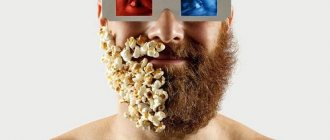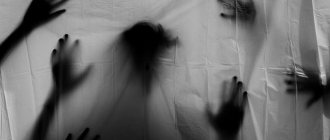Hallucinations in older people are sensory, visual, auditory, tactile, olfactory or complex sensations that do not exist in reality and are the product of the patient’s brain. Observed in mental disorders, degenerative and vascular diseases, and other cerebral pathologies. Often occur after an ischemic or hemorrhagic stroke.
To schedule a consultation, call 8(969)060-93-93.
Causes
The pathological condition is of a polyetiological nature. Why do older people hallucinate:
- Neurological, mental and somatic pathologies : schizophrenia, epilepsy, post-stroke condition, severe cerebral atherosclerosis, trauma, neoplasms and inflammatory diseases of the brain, endocrine and metabolic disorders, endogenous intoxications. A common cause is senile dementia.
- Taking medications. Elderly people may be prescribed medications that affect the psyche: psychostimulants, tranquilizers, anticonvulsants, antituberculosis, antiviral and antibacterial agents. Hallucinations usually occur with an overdose or prolonged use of drugs. A significant role is played by forgetfulness, which contributes to repeated taking of pills, and neglect of the doctor’s recommendations regarding dosage.
- Isolation, lack of sensory impressions. Old people are often alone for long periods of time. The brain, suffering from a lack of sensations, begins to create something non-existent to fill the void. This effect is especially pronounced in cases of severe impairment of the functions of the sensory organs - complete or almost complete blindness and deafness.
- Chronic sleep disorders . Insomnia, nightmares, late falling asleep and early awakenings lead to overwork and psycho-emotional exhaustion. Distorted perception of the environment and short-term illusions due to lack of sleep are observed even in young people. In old age, these phenomena are aggravated due to concomitant diseases and disorders of the brain.
Features of delirium in the elderly
Hallucination is a pathology, the essence of which is that the real vision of the world is significantly distorted.
If an old man practically loses touch with the events of everyday reality, then he is diagnosed with a mental disorder. It is embodied in various images that are not related to the environment, and in no way reflects what is happening around the patient.
In other cases, the older person picks up on what loved ones say or do, but interprets their behavior in his own way.
In such cases, caring for him becomes much more difficult. If an elderly person practically does not comprehend the situation or reacts aggressively to his hallucinations, then caring for him at home becomes too difficult.
Why delirium occurs, medicine and psychiatry have still not found a clear answer.
Nevertheless, scientists have a number of assumptions that are quite close to the truth. Most often, a delirious state occurs due to painful changes in brain structures. They form an inadequate response to irritation of the organs of perception of reality and respond to them accordingly.
The main factors leading to the development of pathology are:
- Alzheimer's disease.
- Excessively low mobility of an elderly person. The need to remain in a lying position for a long time.
- Intoxication in old people suffering from cancer, disorders of the liver or endocrine system.
- Infections affecting the brain or nervous system.
- Loneliness and inability to compare your feelings with the real picture of what is happening.
- Internal diseases, neoplasms or brain injuries.
- Taking certain pharmacological drugs, the side effect of which is confusion.
- Too long and deep sleep. In some cases, hallucination may be a consequence of chronic lack of sleep as a result of insomnia.
- Chronic depression with fear of a deterioration in the general condition of an elderly person, the threat of contracting an incurable disease or a premonition of imminent death.
- Schizophrenia and some other specific causes.
Classification
Hallucinations can be true or false. In the first case, non-existent sounds, visual images, etc. look as reliable as really existing objects of the surrounding world, and are felt as perceived by the senses. Pseudohallucinations are characterized by some subjectivity; they occur in an imaginary conditional space and often lack a clear structure. The following types of true senile hallucinations are distinguished:
- Spontaneous. They develop on their own, without additional stimulation.
- Reflex. They resemble synesthesia, that is, conditions in which irritation of one sense organ causes signals from another. For example, when listening to music, visual images appear.
- Functional. They are provoked by real sensory stimuli, but acquire non-existent content. For example, the patient hears a human voice in the rustling of leaves or the sounds of flowing water.
Symptoms
The disorder may manifest itself acutely or develop gradually. In chronic pathologies, in the early stages they are sometimes barely noticeable, but in the absence of treatment they progress, becoming more complex, vivid and long-lasting. An elderly person experiences the following types of hallucinations:
- Visual. They appear in the form of individual visual elements (geometric shapes, stripes, spots, flashes) or pictures of a certain content (real or fantastic).
- Auditory. They are represented by individual sounds: rustling sounds, knocking, or have a certain content; they are more often perceived as voices that say something neutral, discuss the qualities of the patient, or order him to perform certain actions.
- Olfactory and gustatory. Mostly unpleasant. Old people smell rotting, they say that food has an unusual taste, it is poisoned or over-salted. Often this becomes the reason for the emergence of overvalued ideas or delusions of poisoning. Pleasant false sensations can also cause problems. For example, a person thinks that he hears the familiar smell of a long-dead partner, so he claims that the sign of a loved one is somewhere nearby, that he has come for him to take him to the next world.
- Tactile. Represents pain, itching, burning, or the sensation of insects crawling under the skin. Trying to get rid of non-existent worms, flies or lice, people constantly process, scratch or tear the skin, which leads to the appearance of wounds and abrasions with their subsequent infection.
With complex hallucinatory manifestations, the patient perceives a non-existent picture created with the participation of several analyzers. For example, he not only hears voices, but also sees people talking to him. Hallucinations in late-life dementia are often complicated by delusions of persecution or harm.
Old people can be so convincing that they manage to win over the people around them, who believe that someone (most often an adult child of the patient) secretly came to add poison, but was noticed.
This creates obstacles to treatment, since the patient himself does not seek help, and his son or daughter is deprived of proper authority in the eyes of others, and all their actions are regarded as attempts to harm.
Full-blown hallucinatory phenomena, especially in combination with delusional disorder, represent a complex problem, so timely detection of the disorder by the patient’s relatives is of great importance. How can you suspect that hallucinations have begun:
- Strange behavior. The patient seems to be looking or listening to something, looks concentrated and alert, but from time to time is distracted from the conversation.
- Features of facial expressions. Voices, images and various sensations evoke seemingly unmotivated emotions: irritation, anger, fear, joy, fatigue, disgust.
- Responses. A person can start a conversation with a hallucinatory voice, scratch the bites of non-existent insects, etc.
- Attempts to isolate. In an effort to get rid of unpleasant phenomena, the patient covers his eyes with his hands when visual images arise or pinches his ears when voices appear.
How else can you help an old person suffering from hallucinations?
In alternative medicine, there are alternative methods that help eliminate hallucinosis. Traditional healers believe that decoctions of herbs, such as comfrey, mignonette, oregano, valerian, and zuznik, have proven themselves well.
Psychiatrists discourage taking these medications for treatment because there is no scientific evidence to show they work. In addition, the side effects that arise from them often outweigh all the benefits.
As an alternative or harmonious addition to the main therapy, there are other ways to treat hallucinations. Much depends on how the patient’s daily routine is organized. Old people suffering from hallucinatory mental disorders are advised to adjust their regimen:
- distribute daytime time so that routine activities are performed at the same hour, and in free intervals do “business”;
- you need to walk every day;
- for physically active people, increase the load a little (run in the morning, do exercises, etc.);
- communicate a lot with relatives, neighbors, friends;
- regularly ventilate the room;
- always maintain order and cleanliness in the house;
- avoid negative phenomena (quarrels, sad films and music).
For old people with reality perception disorders, support from close relatives is very important. After all, the first reason for the occurrence of pathology is a lack of communication and attention.
In conclusion. Psychologists say that with modern developments in medicine, it is impossible to completely cure hallucinations in old people. But this is unlikely to be easy to do in the future, since this disease is caused by irreversible changes occurring in the body of older people. The main goal of therapy is to identify the root causes of hallucinations and influence them with medications.
Cost of services
| CONSULTATIONS OF SPECIALISTS | |
| Initial consultation with a psychiatrist (60 min.) | 6,000 rub. |
| Repeated consultation | 5,000 rub. |
| Consultation with a psychiatrist-narcologist (60 min.) | 5,000 rub. |
| Consultation with a psychologist | 3,500 rub. |
| Consultation with Gromova E.V. (50 minutes) | 12,000 rub. |
| PSYCHOTHERAPY | |
| Psychotherapy (session) | 7,000 rub. |
| Psychotherapy (5 sessions) | 30,000 rub. |
| Psychotherapy (10 sessions) | 60,000 rub. |
| Group psychotherapy (3-7 people) | 3,500 rub. |
| Psychotherapy session with E.V. Gromova (50 minutes) | 12,000 rub. |
This list does not contain all prices for services provided by our clinic. The full price list can be found on the “Prices” , or by calling: 8(969)060-93-93. Initial consultation is FREE!
Treatment
If the disorder is accompanied by delirium, affects the patient’s behavior, or can cause inappropriate reactions that threaten the life and health of the patient or other people, immediate hospitalization in a psychiatric department is indicated. In other cases, the issue of the need for inpatient treatment is decided individually. What to do, how and with what to treat the disorder is determined by the psychiatrist.
Pathogenetic and symptomatic therapy is carried out. An action plan for the underlying disease is drawn up by the appropriate specialist (oncologist, neurologist, etc.). In most cases, conservative techniques are recommended. For resectable tumors, surgery may be required.
The main treatment for hallucinations is antipsychotics, which are often prescribed in combination with tranquilizers and sedatives. After relief of symptoms, cognitive behavioral therapy and measures to restore cognitive and social skills are carried out.
Specialists treat visual and auditory hallucinations and other perception disorders. Registration is made by phone. 8(969)060-93-93.
Auditory hallucinations after alcohol binge
After an alcoholic binge, all kinds of hallucinations often appear, including auditory ones. Moreover, they are often very dangerous and can lead to very unpleasant or terrible consequences. Indeed, in such a state, the alcoholic experiences various fears, cannot sleep normally and react to the surrounding reality. This phenomenon is caused by exhaustion of the body by prolonged consumption of large quantities of alcoholic beverages, often low-quality or surrogate ones. Many alcoholics in this state may hear distinct voices that tell them to cause significant harm to their own health or commit some other illegal or dangerous act. Therefore, often after a few days after drinking, many drinkers commit suicide, murder, or become guilty of serious road accidents.











